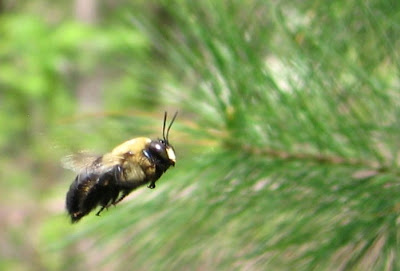Turns out what I have in my yard are not actually bumblebees but carpenter bees. Their shiny abdomens set them apart from bumblebees, which are completely covered in dense hair. Carpenter bees use their mandibles to bore holes in wood, where Miss Queen Bee lays her eggs.
I recall seeing one guy buzzing around the entire garage for a few days. I've learned that he was likely a scout bee, looking for just the right spot for his Queen to lay her eggs. More bees came. They would chase and tangle up with each other, dive bomb me, and then repeatedly return to hang out under the eaves. Research tells me they were anxiously waiting for the arrival of Her Highness.
 |
| Perfectly round holes in the eaves of my garage, compliments of the carpenter bee. |
The question now is: Can I live peacefully with these guys? The males, though aggressive in their protection of their territory, cannot sting. Females rarely do, unless provoked. Males have white or white faces, and females have black faces (I need to remember that). They are phenomenal pollinators, and I will need that in the coming weeks. I'll be planting watermelon, cabbage, Brussels, and kale in this area.
 |
| More bee holes, above planting beds 2 and 3. |
But what about the damage to my garage? Are the bees done boring for the season? If so, perhaps I'll let them be for now, and treat the wood in the fall, hoping they find somewhere else to nest. Reportedly, rubbing or spraying almond oil on the bare wood detracts them. I've also read that the holes can be filled with a small ball of foil and caulked. Do you have any other, chemical-free suggestions?
I'm heading out now to work the soil directly under this area. Black-faced Queen Bee, oh hear me: Please keep your distance. I greatly respect you, I do, and your stinger bee butt.

No comments:
Post a Comment